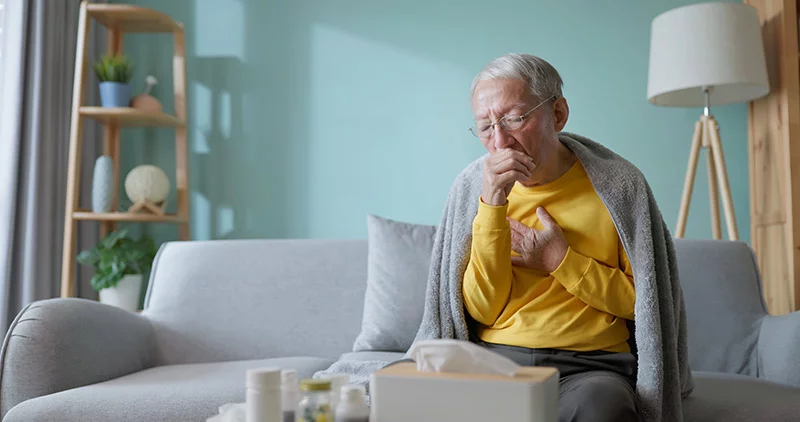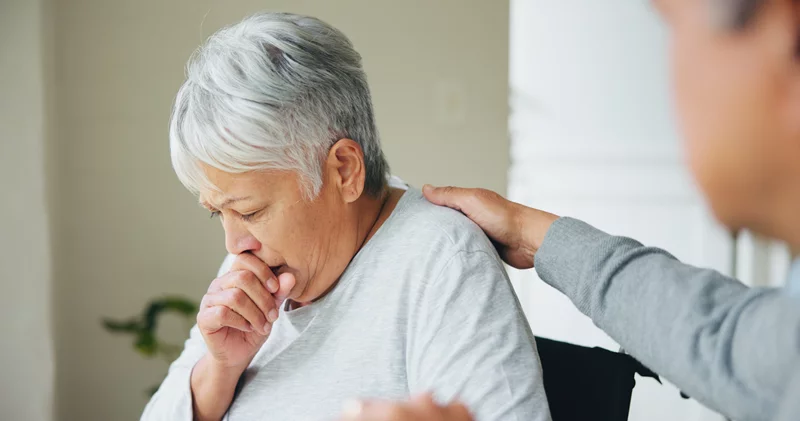NASOPHARYNGEAL SWAB COLLECTION

MATERIALS NEEDED:
- Flocked tipped nasopharyngeal swab with nylon fiber and aluminum shaft (Lawson# 63252).
- DO NOT USE wood-shafted or calcium alginate swabs.
- M6 Viral Transport Media (Lawson# 64758).
PROCEDURE
- Put on a fresh pair of non-sterile exam gloves.
- Gently insert swab into a nostril straight back (not upwards), along the floor of the nasal passage until reaching the posterior wall of the nasopharynx. The distance from the nose to the ear gives an estimate of the distance the swab should be inserted.Note: Do not force swab – if an obstruction is encountered, try the other nostril.
- Leave swab in place for up to 10 seconds.
- Remove swab slowly.
- Bend handle of swab 1.5 to 2 inches straight down towards swab tip. Immediately place swab into the M4 Transport media. Leave swab in transport media. Swab should be entirely enclosed in tube, no wire should extend past lip of tube. Replace lid to transport media, tighten to prevent leakage during transport.
- Label the specimen, place in biohazard bag with completed requisition, and send to laboratory. Transport same day, refrigerated or on ice. If delivery is not expected within 24 hours, freeze at -70 degrees C and ship on dry ice.
Tip: If patient is seated for the procedure, have patient sit with head against a wall as patients have a tendency to pull away during the procedure.
NASOPHARYNGEAL WASH WITHOUT MECHANICAL SUCTION

GOAL: Collect ciliated columnar respiratory epithelial cells from posterior nasopharynx for virus tests
MATERIALS NEEDED:
- Personal protective equipment
- Facial tissue
- Sterile nonbacteriostatic saline (eg. bullets)
- Sealable biohazard bags
- Closable sterile specimen container (eg. sterile urine cup)
- Shipping container with cold pack (off-site clinics or outside clients)
- Syringe method:
- 3-5 ml sterile disposable syringe
- Sterile soft catheter (eg. #8 soft French feeding tube). Base syringe size and tubing length on age and size of patient.
- Bulb method: 1-2 oz tapered tip sterile rubber bulb
COLLECTION METHOD
NOTE: Use two care providers for this technique if possible, one to hold the patient and the other to collect specimen.

- Don PPE. Wipe excess mucus from patient’s nose with facial tissue.
- Fill syringe with 1-4 ml saline. Amount depends on size and age of patient. Attach tubing to syringe tip.
- Tilt patient’s head back slightly beyond “sniff position.” Instruct older patients not to swallow.
- Instill saline into one nostril while holding second nostril closed.
- Aspirate fluid gently while withdrawing and rotating tube to dislodge cells and secretions.NOTE: Recovery must occur rapidly or instilled fluid will rapidly drain down the throat.
- Inject specimen into the container. Repeat with other nostril and inject specimen into same container.
- Label container and place in biohazard bag. Discard syringes and tubing or bulb in biohazard waste.
- Tube specimen immediately to lab or send on wet ice.
NASOPHARYNGEAL WASH WITH MECHANICAL SUCTION

GOAL: Collect ciliated columnar respiratory epithelial cells from posterior nasopharynx for virus tests
MATERIALS NEEDED:
- Personal protective equipment
- Facial tissue
- Sterile nonbacteriostatic saline (e.g. bullets)
- Suction pump or wall suction
- Delee suction trap with attached suction catheter
- Patient Age Catheter size Suction pressure
- Premature 6 80-100 mm Hg
- Infant/Toddler 8 80-100 mm Hg
- School Age 10 100-120 mm Hg
- Sealable biohazard bags
- Shipping container with cold pack (outside clients)

COLLECTION METHOD
NOTE: Use two care providers for this technique if possible, one to hold the patient and the other to collect specimen.
- Don PPE. Remove excess mucus from patient’s nose with facial tissue.
- Determine length of suction catheter by measuring distance from tip of nose to external ear opening. Mark with thumb and forefinger.
- Attach trap to suction tubing, leaving wrapper on suction catheter. Adjust suction to appropriate pressure.
- Tilt patient’s head back slightly beyond “sniff position.” Instruct older patients not to swallow.
- Add 0.5-4 ml saline to nostril (amount depends on patient’s size) to loosen secretions and dislodge cells.
- Gently insert tube into nostril and posterior pharynx until the thumb and forefinger touch the patient’s nose. NOTE: Don’t use lubricants other than saline to aid tube insertion.
- Apply suction while withdrawing and rotating tube. Hold trap upright to prevent loss of secretions from trap. NOTE: Catheter should remain in nasopharynx no longer than 10 seconds
- Repeat procedure for second nostril.
- Disconnect suction. Remove cap with tubing and place in biohazard waste.
- Place new cap on trap. Label trap and place in biohazard bag.
- Tube specimen immediately to lab or send on wet ice.
Artwork and instructions provided by BECTON DICKINSON & CO., Cockeysville, MD Rev 03/30/05






